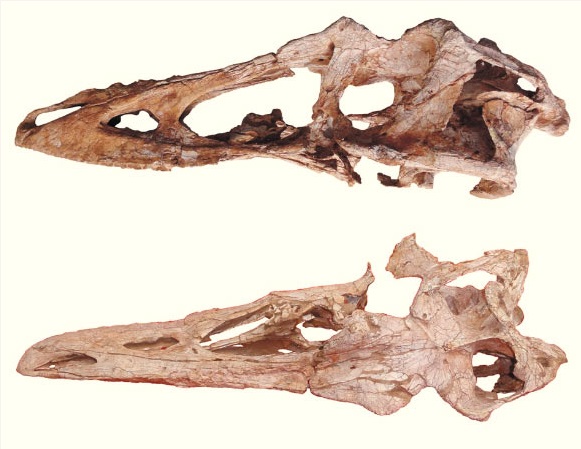On 20 February 1824, William Buckland published the first report of a large carnivore animal: the Megalosaurus. He had a piece of a lower jaw, some vertebrae, and fragments of a pelvis, a scapula and hind limbs, probably not all from the same individual. Buckland’s published description was based on specimens in the Ashmolean Museum, in the collection of Gideon Algernon Mantell of Lewes in Sussex and a sacrum donated by Henry Warburton (1784–1858). One year later, the Iguanodon entered in the books of History followed by the description of Hylaeosaurus in 1833. After examined the anatomy of these three genera, Richard Owen recognized that Iguanodon, Megalosaurus, and Hylaeosaurus share several traits that distinguished them from other ancient or living creatures, like their giant size and five fused vertebrae welded to their pelvic girdle. In April 1842, Owen created the “Dinosauria” : “The combination of such characters, some, as it were, from groups now distinct from each other, and all manifested by creatures far surpassing in size the largest of existing reptiles, will, it is presumed, be deemed sufficient ground for establishing a distinct tribe or suborder of Saurian Reptiles, for which I would propose the name of Dinosauria.“(Richard Owen, “Report on British Fossil Reptiles.” Part II. Report of the British Association for the Advancement of Science, Plymouth, England, 1842)
It was an exciting time full of discoveries and the concept of an ancient Earth became part of the public understanding. The study of the Earth was central to the economic and cultural life of the Victorian Society and Literature influenced the pervasiveness of geological thinking. Mr Venus, the taxidermist in Dickens’s Our Mutual Friend (1864–65) was slightly based on Richard Owen. By the time when Dickens wrote this novel, Owen was the curator of the Hunterian Museum of the Royal College of Surgeons. Our Mutual Friend, also exhibits traces of the work of Lyell, Jean-Baptiste Lamarck, and Darwin. Dickens also published some of Owen’s work in his periodical, Household Words and All the Year Round.
Owen used his influence with Prince Albert, Queen Victoria’s husband, to propose the financing of the three-dimensional reconstruction of the first known dinosaurs: Megalosaurus, Iguanodon and Hylaeosaurus, for the closure of the first international exposition in modern European history: the Crystal Palace exhibition. About six million people visited the Great Exhibition. Megalosaurus became so popular that is mentioned in Charles Dickens’s novel Bleak House: “Implacable November weather. As much mud in the streets as if the waters had but newly retired from the face of the earth, and it would not be wonderful to meet a Megalosaurus, forty feet long or so, waddling like an elephantine lizard up Holborn Hill.” It was the first appearance of a dinosaur in popular literature.
Reference:
Buckland, Adelene , ‘“The Poetry of Science”: Charles Dickens, Geology and Visual and Material Culture in Victorian London’, Victorian Literature and Culture, 35 (2007), 679–94 (p. 680).
Moody, R. T. J., Buffetaut, E., Naish, D.& Martill, D. M. (eds) Dinosaurs and Other Extinct Saurians: A Historical Perspective. Geological Society, London, Special Publications, 343, 335–360
RUPKE, N. A. (2009): Richard Owen. Biology without Darwin. University of Chicago Press: 344
Torrens, H. S. (2014), The Isle of Wight and its crucial role in the ‘invention’ of dinosaurs. Biological Journal of the Linnean Society, 113: 664–676. doi: 10.1111/bij.12341







